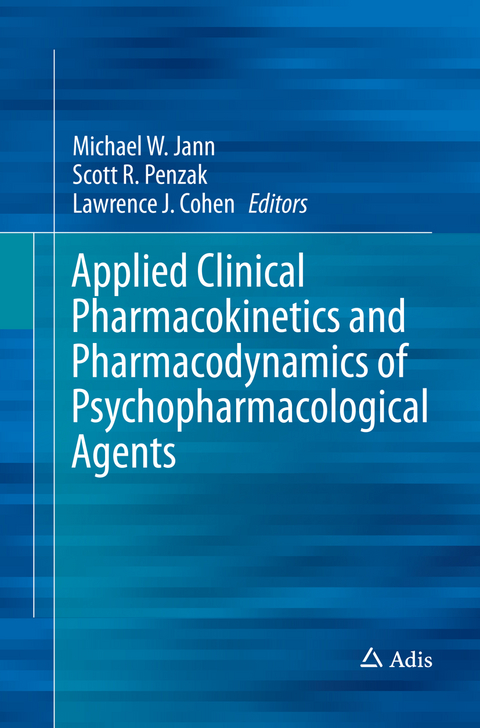
Applied Clinical Pharmacokinetics and Pharmacodynamics of Psychopharmacological Agents
Springer International Publishing (Verlag)
978-3-319-80234-3 (ISBN)
Thisbook is a comprehensive resource on psychotropic medications, detailing thelatest methods for defining their characteristics, their use in differentpatient populations, and drug-drug interactions; an important collection ofinformation forclinicians, students, researchers, and members of thepharmaceutical industry alike.
Thefirst section provides the foundational principles of these drugs. Mathematicalmodeling of parameters that affect their entryto,and exit from, the centralnervous system (CNS) compartment are presented on an individual basis and thenapplied to target populations with specific disease states. Methods andcharacteristics that inform the transfer of these drugs from the laboratorybench to use in patient care are discussed, including imaging techniques,genetics and physiological barriers, such as the blood-brain barrier. The secondsection describes the characteristics of specific agents,nominally arrangedintodifferent therapeutic categories andwith reference crossover use indifferent disease states. The pharmacologic characteristics of different drugformulations are explored in the context of their ability to improve patientadherence. The third section focuses on drug-drug interactions.Psychotropic medicationsfrom different categories are frequently prescribed together,or alongsidemedications used to treat comorbid conditions, and the information provided isdirectly relevant to the clinic, as a result.
Theclinical application of pharmacokinetics and pharmacodynamics of CNS agents hasmade significant progress over the past 50 years and new information is reportedby numerous publications in psychiatry, neurology, and pharmacology.Ourunderstanding of the interrelationship between these medications, receptors,drug transporters, as well as techniques for measurement and monitoring theirinteractions,isfrequently updated. However, with information presented on ahost of different platforms, and in differentformats, obtaining the fullpicture can be difficult. This title aims to collate this information into asingle source that can be easily interpreted and applied towards patient careby the clinical practitioner, and act as a reference for all others who have aninterest in psychopharmacological agents.
Michael W. Jann, Pharm.D., FCP, FCCP is Professor and Chair for the Department of Pharmacotherapy at the University of North Texas System College of Pharmacy (UNTSCP) located at the UNT Health Sciences Center (UNTHSC). Professor Jann received his Doctor of Pharmacy degree from the University of Southern California and post-doctoral training in mental health pharmacy practice at the University of Tennessee Memphis College of Pharmacy. He has published over 230 peer-review articles, abstracts, and book chapters and served as a primary investigator for numerous clinical trials in psychopharmacology. Professor Jann serves on the editorial boards of six peer-review scientific journals including CNS Drugs, Molecular Diagnostics and Therapeutics, The Scientific World Journal - Pharmacology Section, The Consultant Pharmacist, Journal of Clinical Pharmacology, and Journal of Pharmacy Practice. Scott R. Penzak, Pharm.D., FCP, is Professor and Vice Chair for the Department of Pharmacotherapy at the University of North Texas System College of Pharmacy (UNTSCP) located at the UNT Health Sciences Center (UNTHSC). Professor Penzak received his Doctor of Pharmacy degree from Wayne State University and completed his post-doctoral training in infectious diseases at the University of Arkansas for Medical Science (UAMS). Prior to UNTSCP, he was the Director of the Clinical Pharmacokinetics Laboratory at the NIH. He has published over 150 peer-review articles, abstracts, and book chapters, and served as a principal investigator on numerous pharmacokinetic and pharmacogeneticstudies. Professor Penzak serves on the editorial boards of three peer-review scientific journals including Journal of Clinical Pharmacology, Pharmacotherapy, and the International Journal of Pharmacokinetics. Lawrence J. Cohen, PharmD, BCPP, FASHP, FCCP, FCP, FNAP is currently Professor of Pharmacotherapy at the University of North Texas System College of Pharmacy. Examples of Professor Cohen's previous service include, Global Director of CNS Research for Kendle International, Director of the Office of Clinical Trials for University of Cincinnati, and Director of Pharmaceutical Services for the Oklahoma Department of Mental Health and Substance Abuse Services. Professor Cohen received his Doctor of Pharmacy degree and post-doctoral training in psychiatric pharmacy from University of Southern California School of Pharmacy. Professor Cohen has been a Board Certified Psychiatry Pharmacist since the specialty was recognized. His relevant service on Editorial Boards include Current Psychiatry, Innovations in Clinical Neuroscience, Primary Care Companion of the Journal of Clinical Psychiatry, Drug Benefit Trends, Journal of the American Medical Directors Association, CNS News and Pharmacy Practice News.
Section 1. General Pharmacokinetic and Pharmacodynamic Principles ofPsychopharmacological Agents.- 1. Pharmacokinetic Properties.- 2. PharmacodynamicProperties.- 3. PET Scan and Other Biomarkers.- 4. PopulationPharmacokinetics.- 5. Drug Transporters (esp. Blood Brain Barrier).- 6. Pharmacogenomics.-Section 2. Clinical Pharmacokinetics and Pharmacodynamics ofPsychopharmacological Drug Classes.- 7. Antipsychotics - oral typical agents,oral atypical agents, and long-acting injectable (LAI) antipsychotics.- 8. MoodStabilizers.- 9. Antidepressants - tricyclics, selective serotonergic reuptakeinhibitors, serotonergic noradrenergic reuptake inhibitors, monoamine oxidaseinhibitors, and other antidepressants.- 10. Benzodiazepines and Other SedativeHypnotics/Anxiolytics.- 11. Opioid Analgesics.- 12. Stimulants and OtherNon-Stimulants for ADHD.- 13. Cholinesterase Inhibitors and Other AntidementaAgents.- 14. Anti-Addiction Agents.- 15. Anesthetics.- Section 3. ClinicallySignificant Drug Interactions With Psychopharmacological Agents.- 16.Antipsychotics.- 17. Mood Stabilizers.- 18. Antidepressants.- 19.Benzodiazepines and Other Sedative Hypnotics/Anxiolytics.- 20. OpioidAnalgesics.- 21. Stimulants and Other Non-Stimulants for ADHD.- 22. CholinesteraseInhibitors and Other Antidementa Agents.- 23. Anti-Addiction Agents.- 24.Anesthetics.
| Erscheint lt. Verlag | 25.4.2018 |
|---|---|
| Zusatzinfo | XIV, 601 p. 100 illus., 50 illus. in color. |
| Verlagsort | Cham |
| Sprache | englisch |
| Maße | 155 x 235 mm |
| Gewicht | 10304 g |
| Themenwelt | Medizin / Pharmazie ► Medizinische Fachgebiete ► Pharmakologie / Pharmakotherapie |
| Medizin / Pharmazie ► Medizinische Fachgebiete ► Psychiatrie / Psychotherapie | |
| Medizin / Pharmazie ► Pharmazie | |
| Schlagworte | Acetylaldehyde Hydrogenase • Atypical • Candidate Gene • cell membrane • central nervous system • CYP2C19 Enzyme • Emax Model • Grapefruit Juice • Immediate-Release Formulation • Immunosuppressants • Inhibitor • Kappa Opiate Receptor • Modeling Analysis • muscle relaxant • N-Methyl-D-Aspartate (NMDA) Receptor • Non-Steroid Anti-inflammatory Drugs (NSAIDs) • prophylaxis • Protein Binding Interactions • Radiotracer • Receptor systems |
| ISBN-10 | 3-319-80234-8 / 3319802348 |
| ISBN-13 | 978-3-319-80234-3 / 9783319802343 |
| Zustand | Neuware |
| Informationen gemäß Produktsicherheitsverordnung (GPSR) | |
| Haben Sie eine Frage zum Produkt? |
aus dem Bereich


